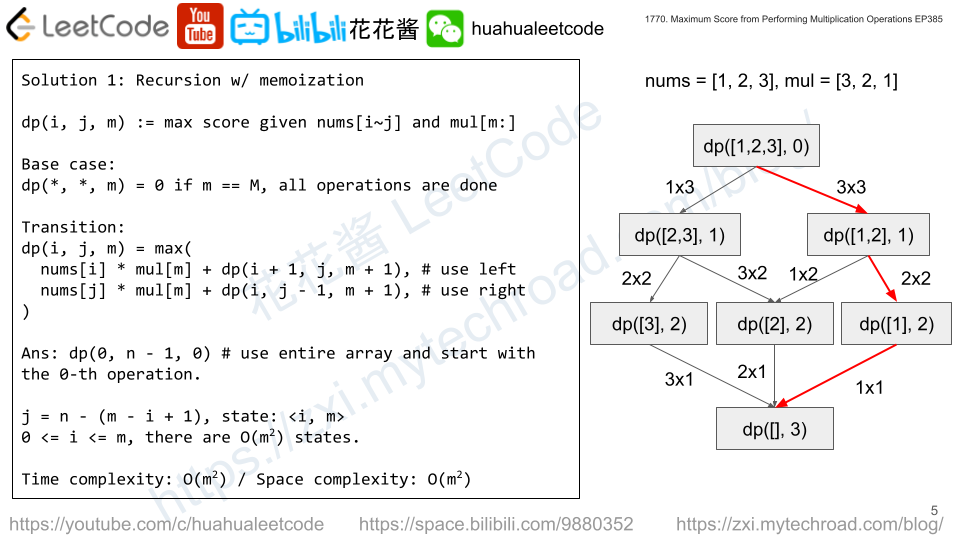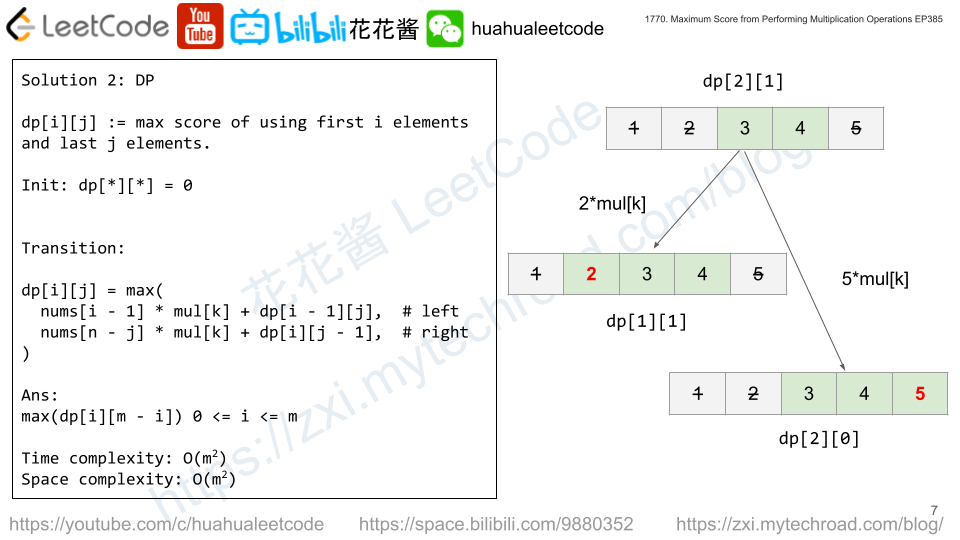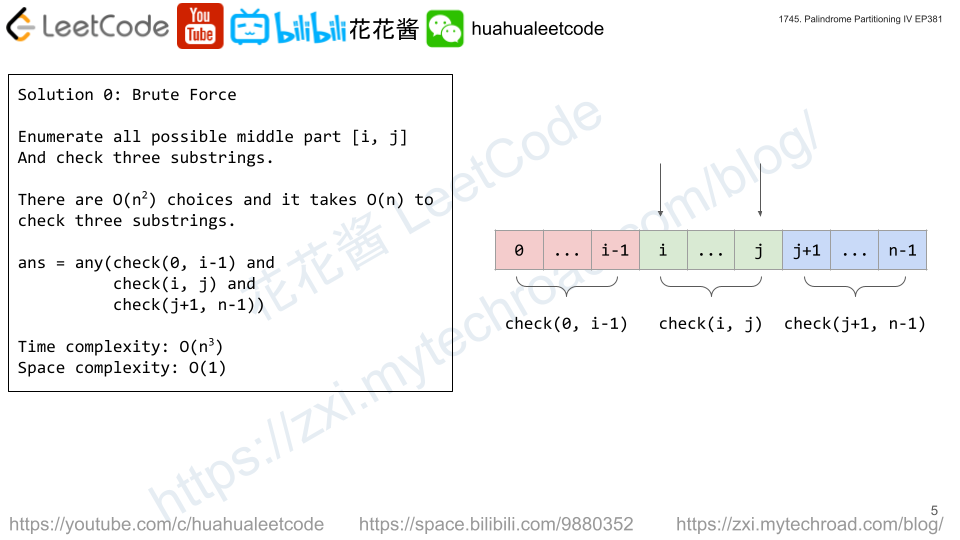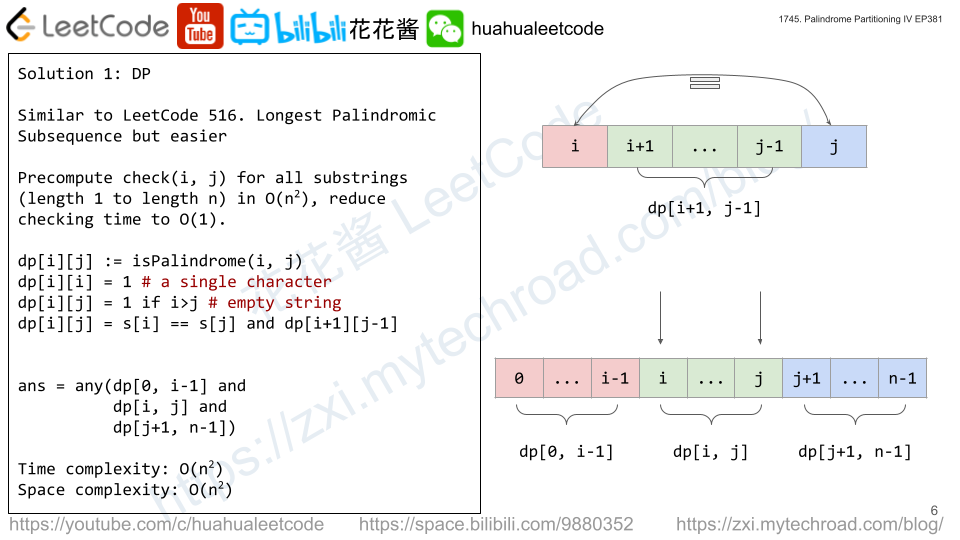You are given two integer arrays nums and multipliersof size n and m respectively, where n >= m. The arrays are 1-indexed.
You begin with a score of 0. You want to perform exactly m operations. On the ith operation (1-indexed), you will:
- Choose one integer
xfrom either the start or the end of the arraynums. - Add
multipliers[i] * xto your score. - Remove
xfrom the arraynums.
Return the maximum score after performing m operations.
Example 1:
Input: nums = [1,2,3], multipliers = [3,2,1] Output: 14 Explanation: An optimal solution is as follows: - Choose from the end, [1,2,3], adding 3 * 3 = 9 to the score. - Choose from the end, [1,2], adding 2 * 2 = 4 to the score. - Choose from the end, [1], adding 1 * 1 = 1 to the score. The total score is 9 + 4 + 1 = 14.
Example 2:
Input: nums = [-5,-3,-3,-2,7,1], multipliers = [-10,-5,3,4,6] Output: 102 Explanation: An optimal solution is as follows: - Choose from the start, [-5,-3,-3,-2,7,1], adding -5 * -10 = 50 to the score. - Choose from the start, [-3,-3,-2,7,1], adding -3 * -5 = 15 to the score. - Choose from the start, [-3,-2,7,1], adding -3 * 3 = -9 to the score. - Choose from the end, [-2,7,1], adding 1 * 4 = 4 to the score. - Choose from the end, [-2,7], adding 7 * 6 = 42 to the score. The total score is 50 + 15 - 9 + 4 + 42 = 102.
Constraints:
n == nums.lengthm == multipliers.length1 <= m <= 103m <= n <= 105-1000 <= nums[i], multipliers[i] <= 1000
Solution: DP


dp(i, j) := max score we can get with nums[i~j] left.
k = n – (j – i + 1)
dp(i, j) = max(dp(i + 1, j) + nums[i] * multipliers[k], dp(i, j-1) + nums[j] * multipliers[k])
Time complexity: O(m*m)
Space complexity: O(m*m)
C++/Top-Down
|
1 2 3 4 5 6 7 8 9 10 11 12 13 14 15 16 17 18 |
// Author: Huahua class Solution { public: int maximumScore(vector<int>& nums, vector<int>& multipliers) { const int m = multipliers.size(); const int n = nums.size(); vector<vector<int>> cache(m, vector<int>(m, INT_MIN)); function<int(int, int)> dp = [&](int i, int j) { const int k = n - (j - i + 1); if (k == m) return 0; int& ans = cache[i][k]; if (ans != INT_MIN) return ans; return ans = max(dp(i + 1, j) + nums[i] * multipliers[k], dp(i, j - 1) + nums[j] * multipliers[k]); }; return dp(0, n - 1); } }; |
C++/Bottom-UP
|
1 2 3 4 5 6 7 8 9 10 11 12 13 14 15 16 17 18 |
// Author: Huahua class Solution { public: int maximumScore(vector<int>& nums, vector<int>& multipliers) { const int m = multipliers.size(); const int n = nums.size(); // dp[i][j] := max score of using first i elements and last j elements vector<vector<int>> dp(m + 1, vector<int>(m + 1)); for (int k = 1; k <= m; ++k) for (int i = 0, j = k - i; i <= k; ++i, --j) dp[i][j] = max((i ? dp[i - 1][j] + nums[i - 1] * multipliers[k - 1] : INT_MIN), (j ? dp[i][j - 1] + nums[n - j] * multipliers[k - 1] : INT_MIN)); int ans = INT_MIN; for (int i = 0; i <= m; ++i) ans = max(ans, dp[i][m - i]); return ans; } }; |




